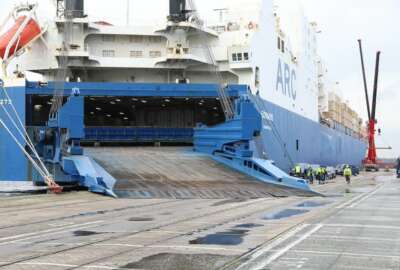

Isabelle Glimcher, a New York University Stern Center for Business and Human Rights fellow, joined Federal Drive with Tom Temin for more discussion.
Best listening experience is on Chrome, Firefox or Safari. Subscribe to Federal Drive’s daily audio interviews on Apple Podcasts or PodcastOne.
Federal procurement has always been about more than getting the right products at the right price. It can be an instrument of national security, or for promoting social policy. On that point, Isabelle Glimcher has published work on how procurement can be a stronger lever for international human rights. The New York University Stern Center for Business and Human Rights fellow joined Federal Drive with Tom Temin for more discussion.
Interview transcript:
Tom Temin: Ms. Glimcher, good to have you one.
Isabelle Glimcher: Thanks so much for having me.
Tom Temin: Your study has looked at several channels of the supply chain where the purchase of products can somehow make worse human rights violations. What are those four general areas that you found?
Isabelle Glimcher: Yeah, so we decided to focus the report on technology, minerals, food — which includes meat and agriculture and fishing — and apparel. And we picked those four because their supply chains where there’s an incredibly well documented history of, pattern of rights violations around the world. The supply chains are incredibly complex, which only creates more room for these rights violations to occur. And perhaps most importantly, a lot of the time in these sectors, the US government is buying what’s called COTS or commercially available off the shelf items, which are items that are sold to the government without really any modification from how they’re sold to the public. Which means that the US government is buying it from exactly the same supply chains where these rights violations are commonplace, and there’s fewer oversights under the law.
Tom Temin: Now the government is not buying from the violators directly. This would be in the raw materials, because there is a Buy American, at least in the part of the finished product rule, for federal procurement.
Isabelle Glimcher: Right. So the Buy American Act applies to certain types of procurement. But you’re right, this is less a problem with prime subcontractors. The main problem is one of globalization. And it’s happened naturally, it hasn’t been driven by the US government in any way. But the supply chains have spread around the world. They’re incredibly complex, we’re getting parts from all over the place that are assembled in one place shipped in another. And that creates a string of subcontractors for whom the law is supposed to apply equally, especially around issues like human trafficking. But there’s just not the oversight that we need to ensure that all those sort of labor law requirements are being matched
Tom Temin: Give us some examples of what the government might be buying, COTS types of products, where this leads to encouragement or benefit to other companies that commit human rights violations.
Isabelle Glimcher: Sure. So apparel is sort of a go to example in this field in general. There was a big report done by the New York Times back in 2013 that showed that these factories in Bangladesh and Cambodia and Vietnam and Thailand were making clothes for the Smithsonian Institute to be sold in their gift stores or making US Marine Corps t-shirts to be sold in military stores. And they found a lot of evidence of pretty severe rights violations. So everything from sort of wage confiscation, physical harassment, really constant surveillance, with cameras mounted even in bathrooms, and a lot of child labor.
Tom Temin: What countries might be involved here?
Isabelle Glimcher: So in this study, it was Bangladesh, Thailand and Cambodia. But I think that for garment, the supply chains are spreading. A lot of our garments are being made in Ethiopia as well now. And the problem is, as I said, the supply chains are so complex. And they’re the same supply chains that multinational corporations are relying on and have put a huge amount of pressure to drive the price down and to speed up turnaround time for what we are now referring to as fast fashion. And unfortunately, the government is sort of looped up in the same supply chains.
Tom Temin: And what about food, for example?
Isabelle Glimcher: Yeah, so there was a really big study that was done on the shrimping industry in Thailand, and it showed that a huge number of people working on these boats are forced laborers. And so they are what we call modern slaves. The thing about food, it’s really, we get a lot of our food from the United States to some extent, especially as compared to other sectors, but there’s still a ton of it coming in from outside. And the US government just doesn’t really have the resources to monitor as actively as would be necessary to guarantee that all of the farms around the world that are producing goods for the American government are done so in what we would consider to be ethical ways.
Tom Temin: So what are your recommendations for, I mean this is a very diffuse activity across the federal government, there is a policy several policymaking bodies within the government. How can they find out what’s going on and then get around it?
Isabelle Glimcher: Yeah, absolutely. So my report comes up with a series of six, to be frank, very ambitious recommendations. I think that a preliminary step would be, it would be great to have agencies review their spending, and try to identify the areas where they are procuring goods from high risk areas, because these recommendations will need to be implemented in an incremental way. And it’ll be good to know where to start essentially, My recommendations also try really hard to acknowledge the fact that the procurement infrastructure in the US government doesn’t have the capacity to do a lot more than it’s already doing. It’s an incredibly overworked and committed group of people. So it tries to sort of shift some of the burden away from them, and rely on experts. So there’s six recommendations, so I’ll just sort of walk through them quickly. The first is to create a binding code of conduct that would be included in all high risk procurement contracts, and would apply to all prime contractors and subcontractors. So the code should be based on International Human Rights and Labor Law. And it can build on the existing prohibitions against forced labor and human trafficking, which are already included in the Federal Acquisition Regulations or the FAR. And it should address workplace safety, prohibitions on workplace discrimination and harassment, reasonable working hours, fair wages and freedom of association. And the second is to build a human and labor rights risk assessment into the solicitation stage of all federal procurement and reward compliance and high risk procurement award decisions. The third is to rely on external monitors. And this is a big one, because the program really doesn’t work without monitoring. But the US government, like I said, just isn’t well positioned to take it on, especially in most agencies. So I think we should rely on external experts to make sure that things are happening as we’re being told that they’re happening
Tom Temin: Almost as if the FDA has inspectors placed in foreign drug facilities to make sure they follow rules.
Isabelle Glimcher: Exactly. And they would be accredited by the US government, they would be tasked based on, sort of triage basically to different facilities around the world. The fourth recommendation would be to impose additional requirements on contractors engaged in high risk contracts. So in addition to following the code of conduct, they should be expected to conduct human rights due diligence on all subcontractors, establish a mechanism through which employees can safely report violations, educate their employees about their rights, work with monitors and create and implement corrective action plans in cases of violation. Fifth, we have to use penalties as a last resort to enforce compliance. But again, this whole system is designed to work with contractors to try to support them to make their supply chains what we would call clean. And so the penalties are really only intended as a last resort and should escalate slowly. Contractors should always be given the opportunity to challenge any sort of penalty that they receive. And then finally, I think we need to build human and labor rights expertise among federal procurement officers so that they know what the risks are they know how to interpret and assess, monitor findings and corrective action plans, and how to identify potential violations.
Tom Temin: And where did this report go? What hands are they in? These recommendations, which eyes are seeing them?
Isabelle Glimcher: Sure. So we are trying to get basically as many eyes as we can on them. We think that these recommendations accord with the priorities of both parties. They are in line with major labor rights commitments that are already applicable in the United States. And this would just be about applying a version of them abroad. And it’s also designed to help American companies and American contractors compete on a level playing field because they already have to adhere to all of these labor rights requirements, but they’re competing against people who can undercut their prices by shortchanging their workers.
Tom Temin: Isabelle Glimcher is a fellow at the New York University Stern Center for Business and Human Rights. Thanks so much for joining me.
Isabelle Glimcher: Thank you so much for having me.
Copyright © 2024 Federal News Network. All rights reserved. This website is not intended for users located within the European Economic Area.
Tom Temin is host of the Federal Drive and has been providing insight on federal technology and management issues for more than 30 years.
Follow @tteminWFED


